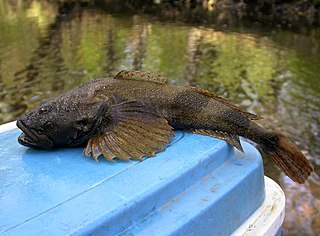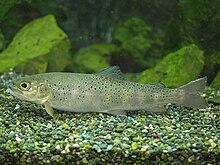
Salmonidae is a family of ray-finned fish that constitutes the only currently extant family in the order Salmoniformes, consisting of 11 extant genera and over 200 species collectively known as "salmonids". The family includes salmon, trout, char, graylings, freshwater whitefishes, taimens and lenoks, all coldwater mid-level predatory fish that inhabit the subarctic and cool temperate waters of the Northern Hemisphere. The Atlantic salmon, whose Latin name became that of its genus Salmo, is also the eponym of the family and order names.

The Amur, or Heilong Jiang, is the world's tenth longest river, forming the border between the Russian Far East and Manchuria/Northeastern China. The Amur proper is 2,824 kilometres (1,755 mi) long, and has a drainage basin of 1,855,000 km2 (716,000 sq mi). Including its source river Argun, it is 4,444 km (2,761 mi) long. The largest fish species in the Amur is the kaluga, attaining a length as great as 5.6 metres (18 ft). The river basin is home to a variety of large predatory fish such as northern snakehead, Amur pike, taimen, Amur catfish, predatory carp and yellowcheek, as well as the northernmost populations of the Amur softshell turtle and Indian lotus.

Coregonus lavaretus is a species of freshwater whitefish, in the family Salmonidae. It is the type species of its genus Coregonus.

The falcated duck or falcated teal is a gadwall-sized dabbling duck from the east Palearctic.

Thymallus or graylings is a genus of freshwater salmonid ray-finned fish and the only genus within the subfamily Thymallinae. Although all Thymallus species can be generically called graylings, without specific qualification the term "grayling" typically refers to the type species Thymallus thymallus, the European grayling.
Siberian taimen, also known as the common taimen, Siberian giant trout or Siberian salmon, is a species of salmon-like ray-finned fish from the genus Hucho in the family Salmonidae. These fish are found in rivers in Siberia and adjacent regions, and are harvested throughout the year.

Stenodus leucichthys is a species of freshwater whitefish in the family Salmonidae. In the strict sense its natural distribution is restricted to the Caspian Sea basin, and it is known as beloribitsa. The beloribitsa is now considered extinct in the wild, but survives in cultured stocks. The nelma, a more widespread species of Eurasian and North America, is sometimes considered its subspecies.
Thymallus yaluensis is a putative species of freshwater fish, a grayling in the salmon family Salmonidae. It is endemic to the upper Yalu River in Korea, on the Chinese border.
Salvelinus curilus is a species of anadromous fish in the salmon family. It inhabits the waters of Russian Far East in the Kurile Islands, Sakhalin, Primorye and also Korea and Japan. It has mostly been considered a subspecies of the Dolly Varden trout Salvelinus malma, with the name Salvelinus malma krascheninnikova, and referred to as the southern Dolly Varden or Asian southern form Dolly Varden trout.

The Manchurian hare is a species of hare found in northeastern China and Russia, the Amur River basin, and the higher mountains of northern North Korea. It lives in forests and the IUCN has assessed its conservation status as being of "least concern".

The houting is a European species of whitefish in the family Salmonidae that was long thought extinct. It was native to the estuaries and rivers draining to the North Sea. The houting is distinguishable from other Coregonus taxa by having a long, pointed snout, an inferior mouth and a different number of gill rakers. The houting once occurred in Belgium, France, Germany, the Netherlands and England. In 2023, DNA analysis found the houting to be genetically indistinguishable from Coregonus lavaretus, and therefore not extinct.

Salmo dentex is a variety of trout, a freshwater fish in the family Salmonidae, found in the western Balkans. Until recently the identity, biological distinctness and species status of the dentex trout were not properly clarified, but genetic data now suggest it is not a monophyletic unit that could be distinguished from other salmonids as a separate species.

Lenoks, otherwise known as Asiatic trout or Manchurian trout, are salmonid fish of the genus Brachymystax, native to rivers and lakes in Mongolia, Kazakhstan, wider Siberia, Northern China and Korea.

Cyprinus rubrofuscus, the Amur carp, is a species of cyprinid fish, and is the wild form of the well-known koi. It is widespread in the fresh waters of eastern Asia, native to China, Korea, Russia, Vietnam and Laos from the Amur to Red River basins, and has also been introduced outside its native range. It is known for its muddy flavor and boniness, hence, it is not commonly eaten by locals except when stewed.

The Amur sculpin, also known as the Ussuri sculpin, is a species of freshwater ray-finned fish belonging to the family Cottidae, the typical sculpins. This species is found in eastern Asia where it is found in Russia, China and Mongolia - in the Amur River basin and some adjacent territories. The Amur sculpin grows to a maximum published total length of 20 cm (7.9 in). This species is the only known member of its genus, Mesocottus. According to the result of a pilot phylogenetic analysis, the freshwater Mesocottus is a sister lineage to the Cottus clade.
Salvelinus inframundus, also known as Orkney charr is a cold-water fish in the family Salmonidae which is endemic to Scotland.

Brachymystax tumensis, the blunt-snouted lenok, is a salmonid fish distributed in rivers and lakes in Eastern Asia. It was formerly included in the more widespread species Brachymystax lenok, but more recent research based on differences in morphology and genetics have justified a distinction of the two species.
The Alashanian pipistrelle is a species of bat in the family Vespertilionidae. It is found in China, South Korea, Mongolia, Japan, and Russia.
Brachymystax savinovi is a salmonid fish species endemic to Markakol Lake and adjacent rivers in eastern Kazakhstan. It was formerly included in the more widespread species Brachymystax lenok.













